Introduction: A Leading Light of the Flemish Baroque
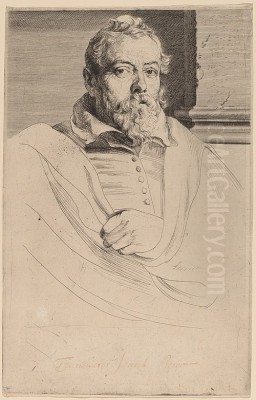
Frans Francken the Younger (1581–1642) stands as one of the most significant and prolific painters of the Flemish Baroque era, particularly active in the vibrant artistic hub of Antwerp during the late 16th and early 17th centuries. He was not merely an artist but the most renowned member of an extensive dynasty of painters, the Francken family, whose collective output significantly shaped the Antwerp art scene for generations. Born into this artistic lineage, Frans II inherited a tradition but forged his own distinct path, becoming celebrated for his versatility, technical skill, and innovative approach to subject matter.
His reputation rests largely on his mastery of small-scale panel paintings, often referred to as cabinet pictures. These works, executed with meticulous detail and complex compositions, catered to the burgeoning market of private collectors. While adept at traditional religious, historical, and mythological themes, Frans II is perhaps best remembered for popularizing new genres, including the allegorical Kunstkammer (gallery paintings) and the whimsical Singerie (monkey scenes), demonstrating a unique blend of erudition, technical brilliance, and sometimes, subtle humour. His bustling workshop became a major production centre, further cementing his influence.
Early Life and Artistic Formation in Antwerp
Frans Francken II was born in Antwerp in 1581, a city then experiencing its Golden Age as a major European centre for commerce and culture, despite the ongoing political and religious turmoil of the Eighty Years' War. He was the son of Frans Francken I (1542–1616), a respected painter in his own right and the patriarch of the artistic dynasty. Art was the family business, and young Frans II received his initial training within this environment, learning directly from his father.

His artistic education was further enriched by the guidance of his uncle, Hieronymus Francken I (c. 1540–1610), another established painter who had spent considerable time working in France, bringing cosmopolitan influences back to the family circle. Some sources suggest that Frans II himself may have spent time studying or working in Paris, possibly with or under the influence of his uncle Hieronymus, though concrete evidence for this remains elusive. Regardless, his formative years were steeped in the techniques and traditions of late Mannerism transitioning into the early Baroque, providing a solid foundation for his future career.
Entering the Guild and Establishing a Career
The Guild of Saint Luke was the primary institution governing artists and artisans in Antwerp and other Netherlandish cities. Membership was essential for any artist wishing to practice independently, take on apprentices, or sell their work legally. Frans Francken the Younger achieved the status of 'master' within the Antwerp Guild in 1605, a formal recognition of his skills and his right to establish his own workshop.
His talent and diligence quickly brought him recognition within the Guild's hierarchy. In 1614 (some sources state 1616), he was elected as one of the deans (deken) of the Guild. This prestigious position not only reflected his standing among his peers but also involved administrative responsibilities, demonstrating his integration into the city's artistic establishment. Holding such a role would have further enhanced his reputation and network, facilitating collaborations and securing commissions.
The Francken Dynasty: A Family Affair
The Francken family represents one of the most extensive artistic dynasties in Flemish art history, spanning several generations from the mid-16th century well into the 17th century. Frans II was arguably the most talented and certainly the most famous member, but he operated within a complex web of familial artistic activity. His father, Frans Francken I, laid the groundwork. His uncles, Hieronymus I and Ambrosius I (1544–1618), were also successful painters.
Frans II had brothers who were artists as well, notably Hieronymus II (1578–1623) and Ambrosius II (c. 1590–1632). The artistic tradition continued into the next generation with Frans II's own sons, Frans III (1607–1667) and Hieronymus III (1611–1671), who trained in his workshop and continued painting in a style heavily influenced by their father. This proliferation of artists within the same family, often sharing the same first names (Frans, Hieronymus), creates significant challenges for art historians regarding the attribution of specific works.
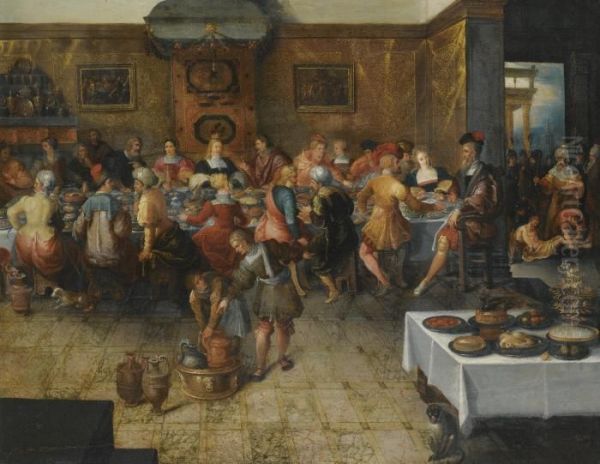
Many paintings from this period are simply signed "F. Francken," making it difficult to distinguish between the works of Frans I, Frans II, and even Frans III, particularly during transitional periods or when workshop collaboration was involved. This complexity underscores the nature of art production at the time, where the family workshop often functioned as a collective enterprise, albeit usually under the direction of the most prominent master, in this case, Frans II for much of his active period.
Artistic Style: Detail, Color, and Evolution
Frans Francken the Younger's style is characterized by its refinement, clarity, and meticulous attention to detail, particularly suited to the small scale of his preferred cabinet pictures. He excelled at rendering textures, fabrics, and the human form with precision. His compositions are often densely populated and intricately arranged, inviting close inspection from the viewer.
In his earlier works, Francken often employed a palette dominated by warmer tones, including rich reds, olive greens, and earthy browns, applied with relatively smooth brushwork. As his career progressed, particularly from the 1620s onwards, his style evolved. Influenced perhaps by the broader trends in Antwerp painting, spearheaded by figures like Peter Paul Rubens, his brushwork became somewhat looser and more fluid, though still controlled.
His later works often feature a cooler, more varied palette with brighter highlights and greater use of transparent glazes. This technique allowed for subtle tonal gradations and added luminosity to his paintings, enhancing the sense of depth and richness. He frequently used copper panels as a support for his paintings, especially for smaller works. The smooth, non-absorbent surface of the copper allowed for exceptionally fine detail and enhanced the jewel-like quality of the paint layers.
Subject Matter: A Wide Spectrum
Frans Francken II demonstrated remarkable versatility in his choice of subject matter, catering to the diverse tastes of his clientele, which included wealthy burghers, clergymen, and nobility. His oeuvre encompasses a broad range of themes common in the Baroque period.
Religious Scenes
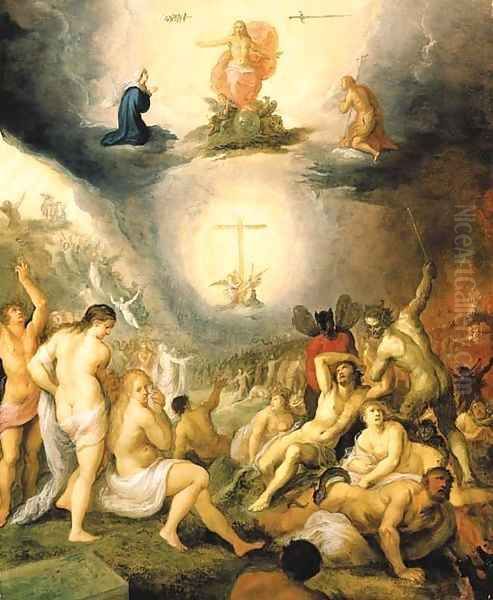
Biblical narratives formed a significant part of Francken's output. He painted numerous scenes from both the Old and New Testaments, often choosing moments rich in narrative potential and allowing for the depiction of numerous figures and elaborate settings. Examples include depictions of the Adoration of the Magi, The Passion of Christ, The Parables of Jesus, and scenes from the lives of saints. The Wedding at Cana, showcasing Christ's first miracle, was a subject he returned to, allowing for a display of feasting and numerous figures. The Deliverance of St Peter highlights his mature style with its dynamic composition and handling of light. He also produced larger altarpieces for churches, although his fame rests more on his cabinet paintings. The Last Judgement was another complex theme he tackled, showcasing his ability to manage large numbers of figures in dramatic compositions.
Mythological and Allegorical Works
Classical mythology provided another rich source of inspiration, allowing Francken to depict dramatic narratives and the human form, often with moralizing undertones. He painted scenes featuring gods, goddesses, and heroes from Greco-Roman myths. Closely related were his allegorical paintings, which conveyed abstract concepts or moral lessons through symbolic figures and scenarios. These often drew on complex iconographic programs popular among the educated elite of Antwerp. Themes like the Allegory of Opportunity or the Triumph of Time were typical subjects.
Historical Paintings
Francken also depicted historical events, both ancient and contemporary, although these are less common than his religious or mythological works. These paintings often served to commemorate specific events or illustrate historical narratives that held particular significance for his patrons or for the broader cultural context of Antwerp.
Pioneering New Genres
Beyond traditional subjects, Frans Francken II played a crucial role in developing and popularizing several innovative genres that became hallmarks of Flemish painting in the 17th century.
Kunstkammer Paintings: The World in a Room
Francken is considered one of the earliest and most important practitioners of the Kunstkammer or 'gallery painting' genre. These paintings depict imagined or idealized collector's cabinets or art galleries, rooms filled with paintings, sculptures, scientific instruments, natural curiosities (shells, minerals, taxidermy), prints, drawings, coins, and other precious objects. These works celebrated the culture of collecting and encyclopedic knowledge that flourished in Antwerp.
These gallery paintings were complex allegories of worldly knowledge, artistic taste, and sometimes vanitas themes (the transience of earthly possessions and pursuits). They often included portraits of the collectors themselves or allegorical figures representing Painting, Sculpture, or Knowledge. Francken's Kunstkammer paintings are valuable documents of contemporary collecting practices and artistic hierarchies. They showcase his skill in miniature, as he often depicted recognizable works by other famous artists within his painted galleries. Examples include works showing the collections of Antwerp patrons like Sebastiaen Leerse or Nicolaas Rockox (though the famous Dinner at the House of Burgomaster Rockox is a different type of genre scene).
Singerie: Monkeys Apeing Humans
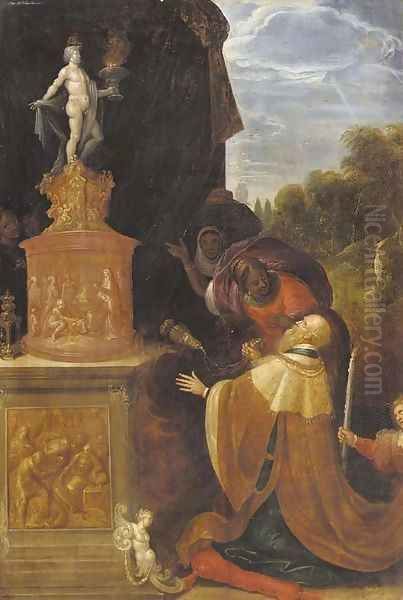
Frans Francken II was also an early popularizer of Singerie (from the French word for 'monkey trick'). These satirical paintings depict monkeys dressed in human clothes and engaging in human activities, such as playing cards, feasting, attending school, or working in studios. These scenes often served as gentle mockery of human follies, vanity, and social customs. The genre tapped into a long tradition of using animals allegorically but gave it a specific, humorous twist. Francken's singeries were highly popular and influenced later artists, most notably David Teniers the Younger, who became a leading exponent of the genre.
Witches' Scenes: Exploring the Supernatural
Another intriguing and somewhat darker theme explored by Francken was the depiction of witches' kitchens (Hexenküche) or witches' sabbaths. These paintings tapped into contemporary anxieties and fascination with witchcraft, magic, and the demonic. Francken's scenes often show witches preparing potions, consorting with demons, flying on broomsticks, or engaging in nocturnal rituals. While sometimes sensational, these works also reflected Counter-Reformation attitudes condemning superstition and heresy, contrasting the chaos of the occult with divine order. These works showcase his imaginative power and ability to create fantastical, often eerie, atmospheres.
Collaboration and Workshop Practice
Like many successful Antwerp masters, Frans Francken II ran a large and highly productive workshop. This was essential to meet the demand for his paintings. He employed assistants and apprentices, including his own sons, Frans III and Hieronymus III, who learned their craft by assisting the master and producing copies or variations of his popular compositions. The workshop system allowed for efficient production and the dissemination of Francken's style.
Collaboration with specialist painters was also a common practice in Antwerp, allowing artists to combine their respective strengths. Francken frequently collaborated with other masters. He is known to have painted the figures (staffage) in landscapes by specialists like Abraham Govaerts and Joos de Momper the Younger. He also worked with still-life painters, such as Andries Daniels, adding figures to their elaborate floral arrangements.
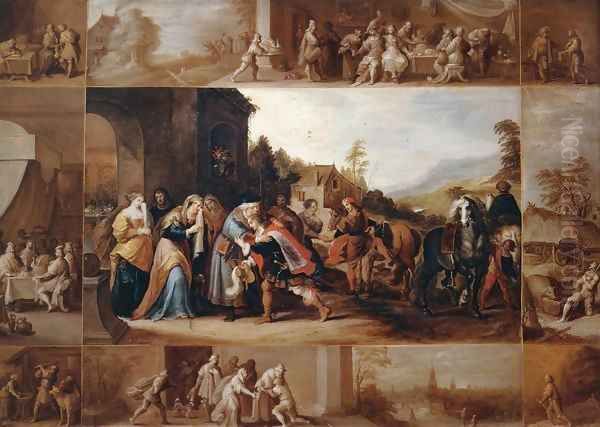
One of his most famous collaborations was with the great Peter Paul Rubens and the flower painter Jan Brueghel the Elder on works like the Allegory of Sight (part of the Allegory of the Senses series, now in the Prado, Madrid), where Francken likely contributed some of the smaller background figures or gallery elements, showcasing the intricate network of Antwerp's top artists. He also collaborated directly with Rubens on works like Madonna in Floral Wreath (c. 1621), where Rubens might have painted the central figures and Francken potentially added surrounding elements or smaller details, although Jan Brueghel the Elder is more famously associated with Rubens for flower wreaths. He is also documented as collaborating with Tobias Verhaecht, a landscape specialist. These collaborations highlight the interconnectedness of the Antwerp art world and the premium placed on specialized skills.
While the user's initial text mentioned collaboration with Pieter Brueghel the Younger, direct collaboration is less documented than Francken's position as a contemporary working in similar thematic areas (religious scenes, proverbs) but with a distinct, more refined style compared to the often more rustic approach of the Brueghel workshop. Their relationship is more one of context and parallel activity within the same market rather than frequent joint production.
Notable Contemporaries and the Antwerp Context
Frans Francken the Younger worked during a period of extraordinary artistic ferment in Antwerp. He was a contemporary of some of the giants of Flemish Baroque painting. Peter Paul Rubens (1577–1640) was the dominant figure, whose dynamic style profoundly influenced the entire school. Anthony van Dyck (1599–1641), Rubens's most brilliant pupil, achieved international fame as a portraitist. Jacob Jordaens (1593–1678) was another major figure known for his robust genre scenes and large-scale history paintings.
Other important contemporaries included landscape painters like Jan Wildens and Lucas van Uden; genre painters like Adriaen Brouwer and David Teniers the Younger (who was influenced by Francken); architectural painters like Pieter Neefs the Elder; and still-life specialists like Frans Snyders and Jan Davidsz. de Heem. Specialists in battle scenes like Sebastiaen Vrancx and figure painters like Hendrick van Balen I were also part of this rich artistic milieu. Francken navigated this competitive environment successfully, carving out his niche with his cabinet pictures and innovative themes. The Counter-Reformation provided significant patronage for religious art, while the wealthy merchant class fueled demand for secular subjects, creating a fertile ground for artists like Francken.
Signature and Identification Challenges
As mentioned earlier, the prevalence of artists named Francken, particularly 'Frans Francken', complicates attributions. Frans II himself attempted to distinguish his work from that of his father later in his career. After his father's death in 1616, Frans II began signing his works "de Oude F. Francken" ('the Elder F. Francken') to differentiate himself from his own son, Frans III, who was becoming active. Before 1616, he often signed "de Jonge F. Francken" ('the Younger F. Francken').
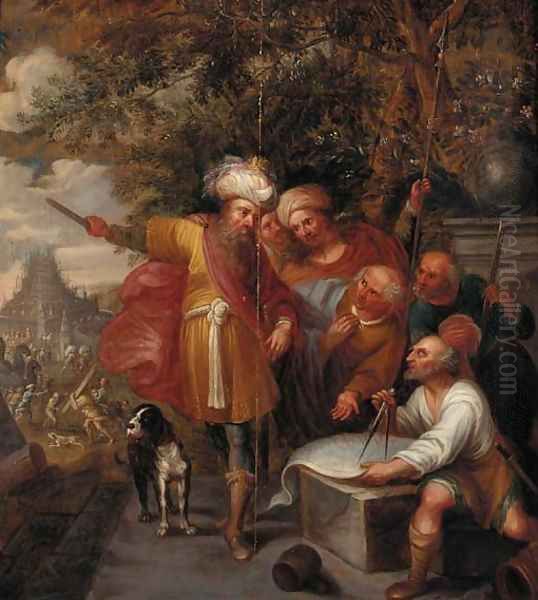
However, signatures alone are not always definitive, as workshop practices involved assistants copying the master's style and sometimes even his signature. Stylistic analysis, comparison with documented works, and technical examination (like dendrochronology for panel paintings) are often necessary to establish attributions more firmly. Despite these challenges, a large body of work is securely attributed to Frans Francken the Younger, showcasing his consistent quality and distinct artistic personality. The Idolatry of Solomon (1622) is an example of a signed and dated work from his mature period.
Legacy and Influence
Frans Francken the Younger was highly successful during his lifetime, both artistically and commercially. His paintings were sought after by collectors across Flanders and beyond. His influence extended through his numerous pupils and the widespread dissemination of his compositions via workshop copies and variations.
His popularization of genres like the Kunstkammer painting and Singerie had a lasting impact. The Kunstkammer genre, further developed by artists like Willem van Haecht and David Teniers the Younger, provides invaluable insights into early modern collecting culture. His singeries spawned a minor tradition that persisted into the 18th century. His detailed narrative style in religious and mythological cabinet pictures also influenced subsequent generations of Flemish painters specializing in small-format works.
Today, Frans Francken the Younger's works are held in major museums worldwide, including the Louvre in Paris, the Prado in Madrid, the Kunsthistorisches Museum in Vienna, the Rijksmuseum in Amsterdam, the National Gallery in London, the Metropolitan Museum of Art in New York, the State Hermitage Museum in St. Petersburg, and the Nationalmuseum in Stockholm, among many others. His paintings continue to be appreciated for their technical virtuosity, intricate detail, imaginative compositions, and fascinating subject matter.
Later Life and Death
Frans Francken the Younger remained active as a painter and head of his workshop throughout his life. He continued to receive commissions and contribute to the artistic life of Antwerp. He successfully navigated the changing artistic landscape, adapting his style while maintaining his core strengths.
He died in Antwerp on May 6, 1642, at the age of 60 or 61. He was buried in the city's St. Andrew's Church (Sint-Andrieskerk), a testament to his status as a respected citizen and prominent artist. His sons, Frans III and Hieronymus III, carried on the family workshop and artistic tradition, though arguably without achieving the same level of innovation or fame as their father.
Conclusion: An Enduring Figure in Flemish Art
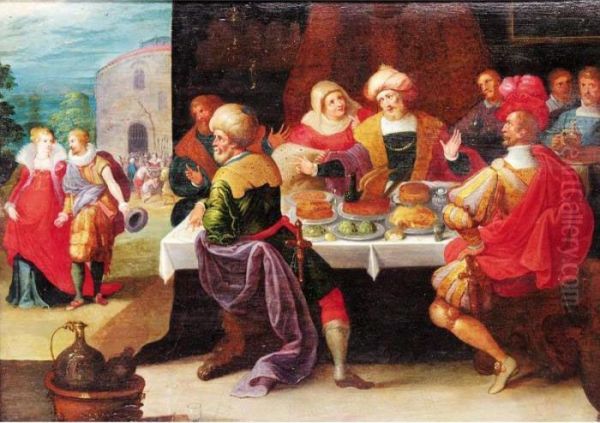
Frans Francken the Younger occupies a crucial place in the history of Flemish art. As the leading member of a prolific artistic dynasty, he mastered traditional genres while simultaneously pioneering new ones that captured the intellectual and cultural preoccupations of his time. His cabinet pictures, renowned for their exquisite detail, rich narratives, and jewel-like quality, catered perfectly to the tastes of 17th-century collectors. Through his innovative Kunstkammer paintings, witty singeries, and evocative witches' scenes, he expanded the thematic boundaries of Flemish painting. His successful workshop and numerous collaborations further amplified his influence. More than just a skilled craftsman, Frans Francken II was an intelligent and imaginative artist whose diverse body of work continues to fascinate and inform us about the vibrant world of Baroque Antwerp.